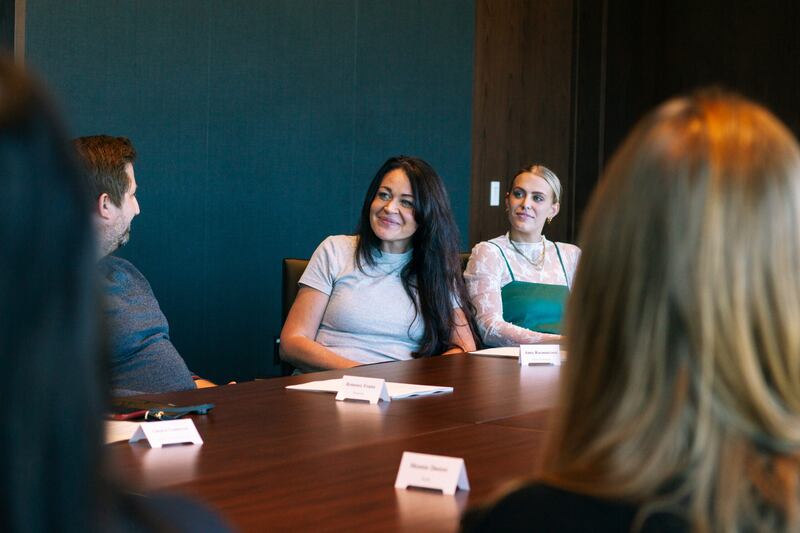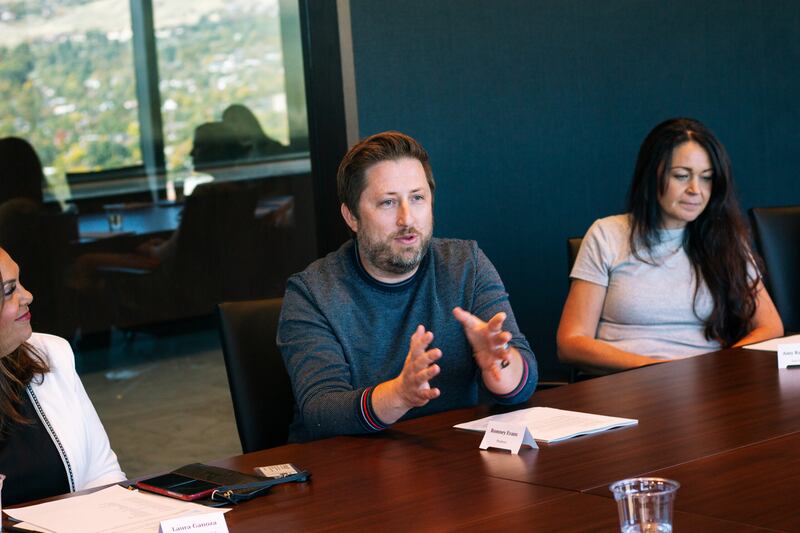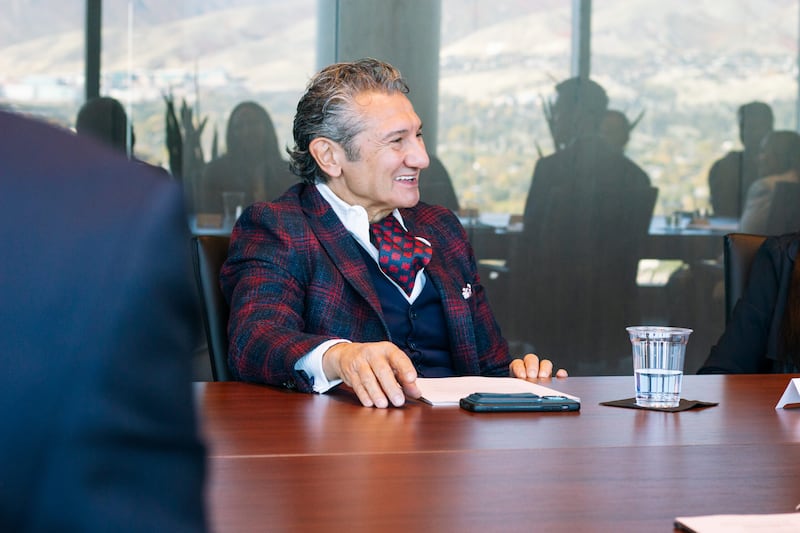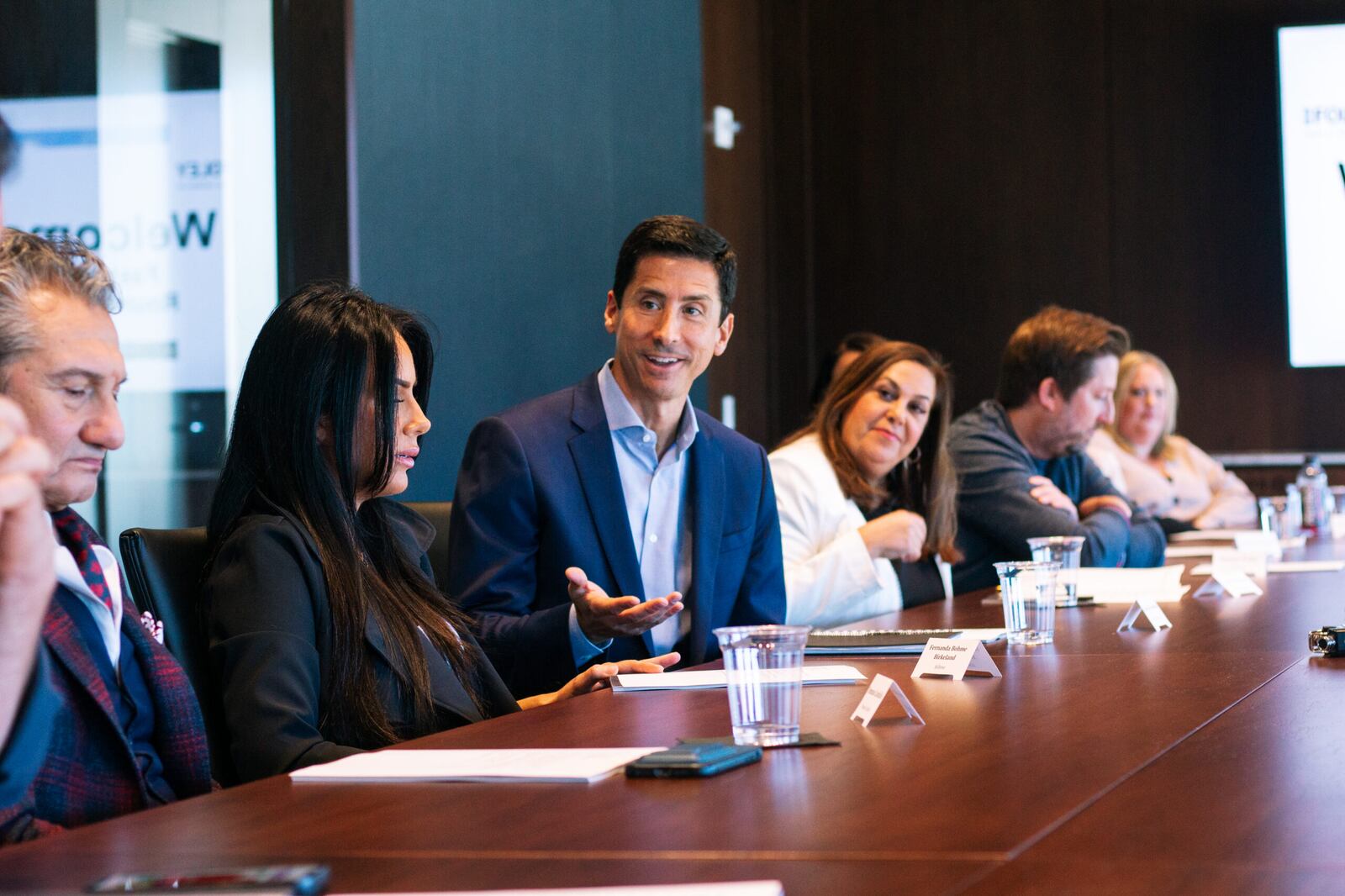Fernanda Böhme Birkeland of böhme, Jonathan Freedman of WTC Utah and Laura Ganoza of Foley & Lardner | Photo by Julia Breinholt Pappas
Last month, Utah Business partnered with Foley & Lardner to host a roundtable on Utah’s fashion industry. Moderated by Jonathan Freedman, president and CEO of World Trade Center Utah, they discussed supply chain difficulties, customer engagement, positive social impact and more.
What drove you to start a brand? What about your brand sets you apart?
Pualeiala Lynn | Owner, Fashion Stylist & Image Consultant | EDYNKEI
I’m a fashion stylist and image consultant with a women’s boutique and event space in Utah County. My boutique has no sizing. There are no tags. You have to come in and try everything on. I help women see that they are the ideal body type—that there is no “ideal.” My work is to help women see their divine beauty.
Stephan Jacob | Co-Founder & COO | Cotopaxi
Cotopaxi is my second business, and it was Davis Smith’s third. We wanted to find ways to genuinely amplify our desire to “do good,” which is still our tagline, into a corporate entity. Based on experiences working with nonprofit organizations, we wanted to find a sustainable, profit-driven model that could generate funds for different efforts. Then, we just happened to start an outdoor brand.
Suzie Turner | Founder | Gibsonlook
Founder & CEO | Stylebuy
I was selling brands to Nordstrom and creating brands for Nordstrom. At some point, I thought it was time to put together a line in my name. [Fashion] moves quickly, especially now with technology. That’s a big part of what I love about it. With technology, there are many new ways to reach your audience and many different things to try. That’s a big part of why I love having my own brand: I have control of it, and it’s a very creative space. It’s been exciting.
Tommaso Cardullo | Founder, Owner & Designer | TOMMASO CARDULLO
Five years ago, I felt that fashion was about not just looking good but also feeling good. My company slogan is “Carpe Vitam,” which means “seize life,” meaning embrace life at any stage. It doesn’t matter if you are 60 or 15—life is a gift. It has been amazing to see many transformations over the last five years.
Fernanda Böhme | Co-Founder | böhme
What is your frequency that you have to share with the world? What gifts do you have to better your community? Back in the day, there was no boutique shopping. Let me tell you, I almost quit after [opening] the first store. People were not accepting of new brands. Today, the environment for entrepreneurs is fantastic. It’s never been better. People are accepting of new ideas, new styles and new technology.
Monte Deere | CEO | Kizik & HandsFree Labs
What would your life be like if you never had to touch your shoes again? If you could just step into them or if your children or aging parent didn’t have to reach over and put on their shoes? [That’s] something our founder, Mike Pratt, envisioned. At Kizik, we’re revolutionizing footwear to make things easier for everyone and life-changing for many.
Zach Jones | CPO | Albion Fit
We’re a local-based women’s apparel retailer. We have six brick-and-mortar locations in four states and our e-commerce business. Our primary focus is women’s swimwear, but we do many other things—accessories, lifestyle. We’ve also transitioned into menswear and licensed apparel in the past two years.
Rachel Nilsson | Founder & CEO | RAGS
RAGS came about naturally because I was a mom and had little kids who were hard to dress. Whenever I changed my youngest’s diaper, I hated the snaps around the legs. I started cutting up random T-shirts and sewing them instead. I love the functionality [of a one-piece]—it is easy on and off. I didn’t want to waste time changing diapers, but I wanted something I was proud to put my kid in that didn’t look like pajamas.
Lexi Cuillard | Founder & CEO | KAXI
I own a company called KAXI. We focus on women’s hair accessories. Five years ago, I realized a huge gap in the marketplace. There were a lot of little girls’ accessories and big-box retailers but nothing specifically tailored toward women, whether that be functional pieces you need every day or fashion pieces. I started out sewing all my pieces, and now we have an awesome manufacturer overseas. We’re about 70 percent direct-to-consumer—that’s been a huge piece of our business. In the last year, we’ve scored an excellent relationship with Free People and are headed heavily into that wholesale space.
Romney Evans | Founder & CEO | Shoptrue
Originally, I started a company called True Fit. It’s a fashion technology company. We spun out a new company 24 months ago, and we’re trying to build what would be akin to a Spotify for fashion. It’s a singular marketplace where we can feature brands and use AI to curate an entire catalog for every user that improves over time.

Amy Rasmussen of Nani Swimwear and Lexi Cuillard of KAXI | Photo by Julia Breinholt Pappas
Amy Rasmussen | Co-Founder & Co-Owner | Nani Swimwear
Many of our nationwide retailers say they love to work with us because our product images show women of all sizes. We’re an active adventure company; you can still do whatever you want, no matter your size. Swimwear is a super crowded market, but there weren’t pieces for the girl who wanted to hike 10 miles in her swimsuit to a waterfall to dive in and be in it all day. That’s where we’ve been successful. Inclusivity is a huge part of our brand and is definitely important.
Consumers want to support brands that have a positive impact. How are you using your brand’s influence for good?
Kacie Malouf | Owner | Downeast Home & Clothing
In 2016, we started the Malouf Foundation. Initially, we were giving away a lot of bedding, but after a couple of years, sexual exploitation hit a nerve with us as something we wanted to tackle. For example, we have a jewelry line where every time we sell a piece of jewelry at Downeast, a dollar goes to the Malouf Foundation to support survivors of trafficking. It’s interesting to be able to leverage our business to raise money for things we care about.
Tiffany Plyler | Sales Operations Manager | Jane.com
At Jane, we created Jane for Good, and we get to do a lot of exciting projects with local people and national breast cancer awareness. Last year, we packed boxes for patients with breast cancer, and our employees all got to help pack the boxes. One thing I love about my job is having opportunities to support people in Utah.
How are you leveraging technology to enhance consumer engagement with your brand? How are you competing with Amazon?
Lexi Cuillard | Founder & CEO | KAXI
We recently launched on Amazon, and it was the worst thing ever. Sales were awesome, and our customers resonated with it. But for the first time in my business, I realized that my competitors are large manufacturers overseas that have way more money than me, have way more resources, and can get products for way less. These larger manufacturers could see how many units we were selling and had a copycat product within six weeks.
Laura Ganoza | Partner | Foley & Lardner
I always say to our clients, “As a consumer, I love Amazon. But when I’m working for my clients, I hate Amazon.” They’re the worst. You give them all the rights when you agree to post with them. They could use so much of your materials and license it. I understand what you’re going through.
Jacob Durham | Co-Founder & CEO | NOMATIC
We used Kickstarter to launch our first product, and it was cool to engage with our customers. That became ingrained in our brand early on because when you launch, you’re presenting an idea—not the final product. We could engage our community before we even manufactured the product to get feedback on how to adjust the product. We changed our product according to what they wanted before ever producing it. Connecting with people and customers is so easy now. Any company creating a product and not tapping into that resource is crazy.
Rachel Nilsson | Founder & CEO | RAGS
An interesting part of the COVID-19 aftermath is seeing brands leaning into their community. It got so wide, then COVID happened, and companies started honing in on community and connecting with consumers. There’s so much value there.
Tiffany Plyler | Sales Operations Manager | Jane.com
At Jane, we are balancing that for all of our sellers, getting them the technology they need to sell well on our site and trying to always build integration. We created a seller app where they can see their sales, but we are trying to give them more data. We also do seller webinars and train them on fashion. We get to see the trends for the season and empower our business owners with that knowledge. With Amazon, there’s a lot of pressure to ship within two business days, with which we run into a big issue.
Monte Deere | CEO | Kizik & HandsFree Labs
I’ll share a couple of hacks that have helped us. One: How do you get a pair of shoes to someone in two days? We weren’t. Two years ago, we were seven or eight days on average. Now, we have two large distribution centers, and then we have these 12 nodes. On average, we’re two days. Another hack that’s been great for us: specialists. Our CMO, Alex McArthur, and our VP of marketing, Brett Swensen, came from Purple Mattress. They are great at using video, so we leverage video.

Romney Evans of Shoptrue | Photo by Julia Breinholt Pappas
What challenges are impacting your business, and how are you solving them?
Fernanda Böhme | Co-Founder | böhme
Talking about online business, I don’t think it’s sustainable when you have TikTok, Instagram, Google—they’re the “kajillionaires” at the end of the day. We’re giving all our money to them in online advertisement because, unfortunately, you have to pay to play. When a newcomer comes in to do business online, they’re competing with the guy putting $50 million a year into online advertising. It’s not sustainable.
Suzie Turner | Founder | Gibsonlook
Founder & CEO | Stylebuy
We do well with our email and SMS and felt an app would be a good opportunity. It has been great, and the app is—for fashion, at least—so easy to change that we can constantly update what we look like and put a new trend out. Those types of things build community. The customer trusts that you’re thinking about why they came to you in the first place.
Utah businesses think globally. How have you built a diversified supply chain?
Zach Jones | CPO | Albion Fit
We have our own vertical operation, which at our size is pretty uncommon. Most of our challenges come from the raw goods or the sides of things we don’t control. Our thesis has been to try and bring as much of the apparel manufacturing process in-house as possible. That comes with a price tag, but we look at it almost like an insurance policy. Five or 10 years from now, we’ll see that down the road.
Laura Ganoza | Partner | Foley & Lardner
In terms of risk, it also lessens the risk of manufacturers ripping off your designs, intellectual property and things like that. If you don’t have control over where items are being manufactured and they’re being manufactured abroad, you end up losing some of that because when they’re not working for you, they’re working for somebody else.
Kacie Malouf | Owner | Downeast Home & Clothing
Diversifying the supply chain is important, but there’s something to be said about solid partnerships. We’ve moved to different manufacturing facilities in an attempt to diversify and then gone back to suppliers that we worked with before. We felt we should diversify when really our relationship with them was strong, the pricing was excellent and everything worked. Developing long-term relationships with different suppliers helps keep your IP and designs quiet. They’ll do that for you if you have that strong partnership.
Tommaso Cardullo | Founder, Owner & Designer | TOMMASO CARDULLO
We have about 16 different suppliers—some do luxury brands, some are just one or two people. It’s all about relationships. Post-COVID, we are more ethically inclined. It’s a win-win; you pay your supplier well, you make your customer happy, you are happy.
Amy Rasmussen | Co-Founder & Co-Owner | Nani Swimwear
We’re working on our supply chains. It’s hard because swimwear is so specialized. The fabric is stretchy. It’s hard to sew. We love our factory; they’re like family. We visit them often, and they visit us. [One of the employees] calls us her sister. If you build those strong relationships, they go the extra mile for you. We know they have our back—they take care of us. It makes it hard to move.
Monte Deere | CEO | Kizik & HandsFree Labs
We’ve gone from one to three factories over the last two years, and we’ve asked these factories to know one another and work together, and they are. We have a summit every year where they come together. That doesn’t always work, but it’s worked for us. They realize, “OK, this is a company that’s growing. They are going to diversify. They won’t make all products in one factory, so let’s work together.”
Jacob Durham | Co-Founder & CEO | NOMATIC
We have one factory that’s been a stellar partner, and we try to take care of each other as much as possible. When COVID hit, they shut down their factory for two months, and we were in a bind. I wish we’d had a backup. One thing we’re trying to do is source new projects with new factories. You can start building that same stellar relationship with another one and another one but still give them all good business with the products they’ve developed with you.
What advice would you give to Utah Business readers who have entrepreneurial ideas and want to start a business?
Pualeiala Lynn | Owner, Fashion Stylist & Image Consultant | EDYNKEI
Learn how to listen to your intuition.
Rachel Nilsson | Founder & CEO | RAGS
I don’t think you’re ever going to be ready. You just figure it out day by day. When I was going on Shark Tank, I remember getting really good advice: “These guys all started somewhere, and they didn’t know everything.” When you’re sitting in a room, pitching big companies like Disney or Marvel, it helps you understand that these people are just regular human beings with normal lives. No one knows everything, so start somewhere.
Romney Evans | Founder & CEO | Shoptrue
So much is just about momentum. If you’re just starting, you’ve got to create a little momentum, and then you can use that momentum for more. You have to work as if it all depends on you. You’ve got to network as if it’s never going to happen without other partners or investors. And you’ll have to synthesize a lot of contradictory advice from many intelligent people. Ultimately, you’ll have to make some calls, and you’ll get it wrong sometimes … but if you just keep working internally and externally, you’ll give yourself lots of chances for a door to open.

Designer Tommaso Cardullo | Photo by Julia Breinholt Pappas


